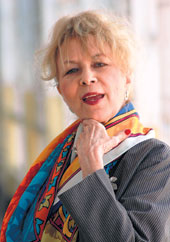 |
| A jubilant Pam Crain on Friday morning wearing the scarf she was presented by the Anglo-Indian community. Picture by Sanjay Chattopadhyaya |
Beaming like schoolgirls, two nuns wearing grey wimples come up to her and gush about how, when they were teachers in their early youth, they would go to Mocambo’s on the pretext of eating tutti-fruttis, just to hear her sing. Another plump homebody caught hold of her hands and exclaimed: “All the ladies of Calcutta wanted to look like her. She would sing at Mocambo’s in her fishtail dress.”
The centre of attraction was Pam Crain, the jazz singer who has seen the rise of Park Street as the hottest night spot of the sub-continent, and also its decline over the years as the spotlight shifted elsewhere.
Not surprisingly, on Friday morning she received the Pride of the Community Award at the ceremony that was part of the three-day annual general meeting organised by The All-India Anglo-Indian Association and The All-India Anglo-Indian Education Institution. The AGM is being held in Calcutta after a gap of 44 years.
The nicest thing about Crain is her sincerity. Although she keeps travelling -- her daughter has moved to the UK and her mother lives in Las Vegas – Crain returns to the city of her birth where she feels her roots are. “I chat with them on the Internet. They seem to be quite scared. Here, I don’t mind going home in a taxi at one and two. Here I can chat with the taxi drivers,” says Crain, who, when offered snacks by her husband Don Saigal, opted for a laddu and a barfi instead of sandwiches.
Crain says her mother is an Anglo-Indian and at age 13 when she was in the boarding of Dow Hill in Kurseong, she was introduced to the piano. “That’s about it,” she says. But they were allowed to take back the discs she bought in a small shop in New Market. “I was consumed by jazz”, her favourite singers being Betty Carter, Sarah Vaughan and Nina Simone. She was “very lucky” to have performed with some of the best jazz musicians the country produced.
Perhaps it was fated that she would subsequently “fall in love” with Carnatic music, for impossible as it may sound, Crain had begun her career at a masala dosa joint named Neera’s on the Chowringhee.
When she returned from Singapore after a year there, she watched Mocambo’s being built. Crain has performed in all the cities, and she says with a smile, “even Indore.”
The crowds are still the same, she feels, but she admits managers of establishments expect the music to play softly in the background. “But just as the people at the restaurant talk business, we want to talk our business too. It is very difficult for a musician to do anything that is not coming out with heartfelt power.”











